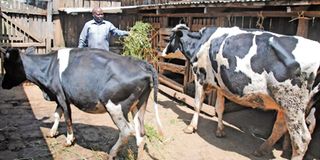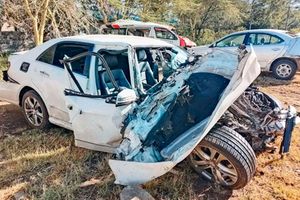Premium
Vet on call: Tips on protecting cattle against LSD

Stephen Thuo feeds dairy cows at his farm in Cheponde, Elburgon. In livestock, lumpy skin disease (LSD) is spread by biting flies, mosquitoes and ticks. Animal health service providers may also spread the disease by using vaccination needles that have been used on infected animals which happens a lot in outbreaks when the vaccinators are carrying out emergency vaccination. PHOTO | JOHN NJOROGE | NATION MEDIA GROUP
What you need to know:
- LSD is spread by biting flies, mosquitoes and ticks. Animal health service providers may also spread the disease by using vaccination needles that have been used on infected animals.
- LSD is spread by biting flies, mosquitoes and ticks. Animal health service providers may also spread the disease by using vaccination needles that have been used on infected animals.
- The farm records showed the animal had been vaccinated against LSD about 18 months before.
- It takes about two-to-three weeks after vaccination for the animals to build sufficient immunity. I still have another week of waiting to see whether any other animals will show signs of infection.
The call from Jane left me very concerned. I did not want to imagine almost 200 dairy cattle with the dreaded lumpy skin disease (LSD).
Jane is the manager of a farm in Naivasha. She was on leave but duty demanded she should call me to find out the best way to respond to an outbreak of the disease on the farm.
Her leave replacement manager, Rono, had informed her one milking cow had come down with LSD. It had swollen legs, lumps on the skin and a temperature of 41 degrees Centigrade. Milk production had ceased and the cow was barely eating.
My first question was why the animals had not been vaccinated against LSD. I recalled having provided a schedule of vaccines to be routinely administered to the cattle annually and some, like foot and mouth disease (FMD), to be given twice a year.
Jane reminded me that the farm had recently had a high turnover of managers. This had disrupted the vaccination programme. We agreed vaccination had to be immediately reviewed and brought up to date.
I mentally reviewed the nature of LSD spread and crafted a containment strategy. I immediately called Rono and detailed the strategy and plan of action. The first thing was to isolate the sick animal to eliminate contact with the other animals.
Second, Rono would ensure that all the other animals were washed with a pyrethroid chemical to protect them from fly and mosquito bites. The washing would be done the following day or as soon as possible.
Finally, I would organise to carry out vaccination of all the healthy cattle above three months old within 24 hours of being washed. There was a risk that some of the animals would be infected and incubating the disease.
MATERNITY IMMUNITY
LSD is spread by biting flies, mosquitoes and ticks. Animal health service providers may also spread the disease by using vaccination needles that have been used on infected animals. This happens a lot in outbreaks when the vaccinators are carrying out emergency vaccination.
“Let us cross our fingers and hope that only a few mosquitoes and biting flies in the area are infected with the LSD virus,” I told Rono.
We executed the activities as planned. When I arrived on the farm two days later to carry out vaccination, I found three other animals had come down with the mild form of LSD.
Two heifers had only swollen limbs and a few small lumps on the skin. They were eating normally and their temperature was only slightly elevated. They had been treated by the local animal health service provider with antibiotics and anti-inflammatories.
One heifer had a swollen leg and an infected oozing wound on the lower left hind leg. The wound had opened the previous evening. I treated the animal with antibiotics and anti-inflammatories.
I instructed Rono to clean the wound with iodine solution and dilute hydrogen peroxide daily for three days and apply wound spray twice daily.
I vaccinated 160 cattle comprising pregnant and milking cows, young stock and calves older than three months.
I did not vaccinate calves below three months to avoid interfering with their maternal immunity and causing infection with the virus.
It is scientifically known that vaccinating animals below three months can neutralise the maternal antibodies and leave the calves open to infection.
REST OF THE HERD
The kind of vaccination I carried out presumes that the viral load on the farm is low and the vaccinated animals will develop sufficient immunity before being exposed to the virus. I was encouraged by the fact that only a few animals had come down with the disease.
The farm records showed the animal had been vaccinated against LSD about 18 months before. I hoped they still retained sufficient immunity to fight the virus.
Two of the infected heifers had very swollen legs. I hoped they would not get injured or get bursts in some areas to create oozing wounds.
Such wounds easily get bacterial infection due to the large amount of fluid accumulated in the leg and damage in the swollen tissues.
Rono inquired whether the unvaccinated calves would require vaccination later before the whole herd was due for revaccination.
A quick calculation showed I had vaccinated 80 per cent of the animals on the farm. Coincidentally, I had achieved the threshold for herd protection against LSD. The unvaccinated calves could wait and be vaccinated together with the rest of the herd in a year’s time.
It takes about two-to-three weeks after vaccination for the animals to build sufficient immunity. I still have another week of waiting to see whether any other animals will show signs of infection.
Fortunately, no other animal has so far shown the disease. My memory goes back to two farms that I once vaccinated against LSD and still 90 per cent of the animals still got mild to severe disease.
I am hopeful the combination of isolation of the sick cows, washing all the cattle with a pyrethroid chemical once a week and the prompt vaccination will contain the disease to the infected cattle.



